By Alan Jones and Mary Fanning | September 8, 2018
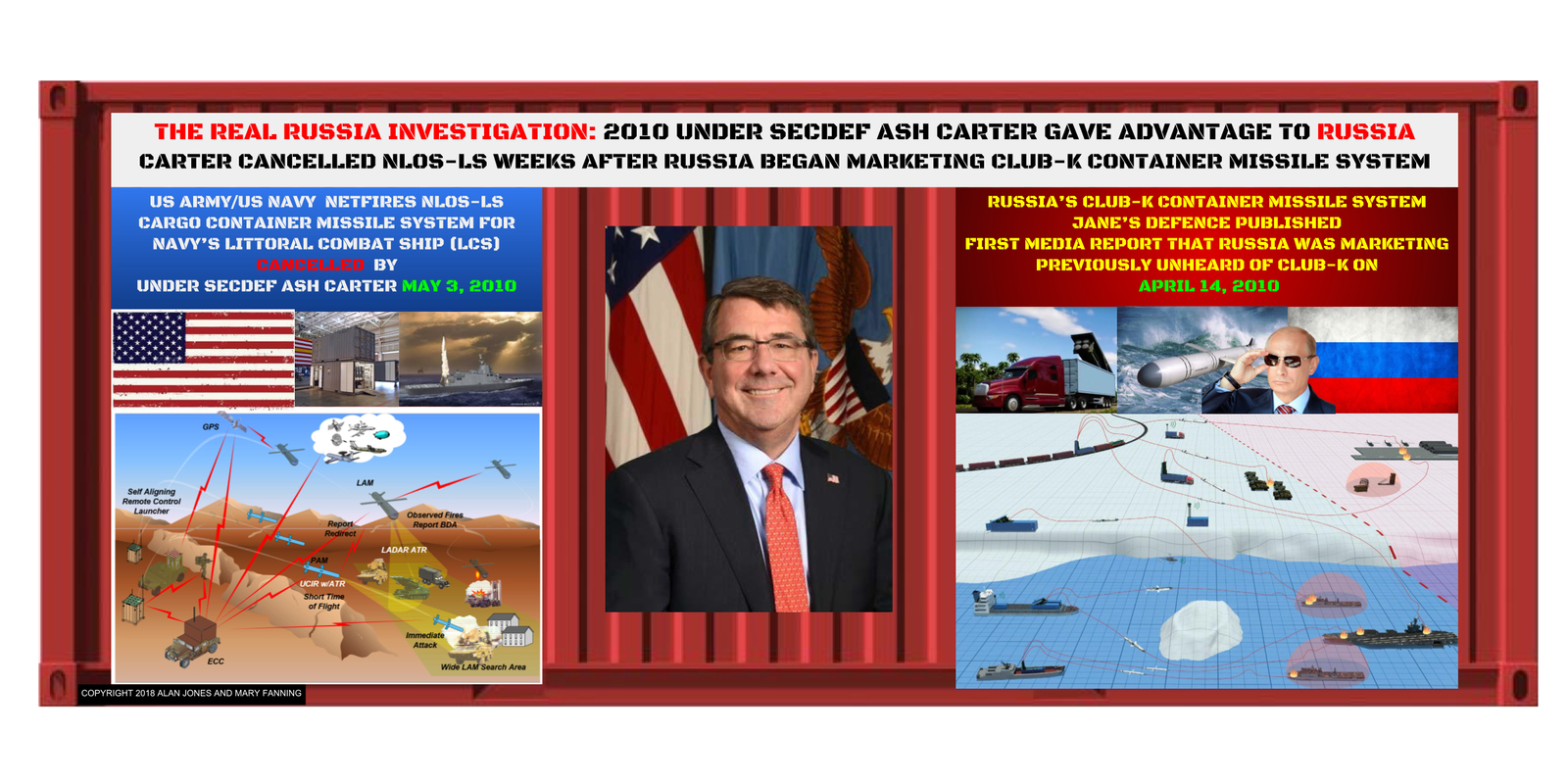
Scrapping 13 years of development costing $1.1 billion, President Obama’s Under Secretary of Defense Ashton Carter inexplicably canceled the Pentagon’s revolutionary NLOS-LS “Missiles in a Box” weapons system in 2010.
Though development of NLOS-LS was 92 percent complete, Under Secretary of Defense for Acquisition, Technology and Logistics Ashton Carter canceled the entire NLOS-LS “Missiles in a Box” program less than one month after “Jane’s Defence Weekly” shocked Western defense experts with a breaking report that Moscow was now marketing Russia’s own “Missiles in a Box” system, the previously unheard of Club-K Container Missile System.
Russia’s Trojan Horse Club-K “Missiles in a Box” system, perplexingly, bears a striking resemblance to the Pentagon’s now-canceled NLOS-LS.
The Pentagon designated its revolutionary “Missiles in a Box” weapon the XM501 Non-Line-of-Sight Launch System (NLOS-LS).
Ash Carter’s cancellation of America’s NLOS-LS, in conjunction with the arrival of Russia’s Club-K, brought about a calamitous shift in the military balance of power that weakened the United States and empowered Russia.
In the April 14, 2010 issue of “Jane’s Defence Weekly,” Robert Hewson stunned the defense community with an alarming report revealing that Moscow was marketing the Club-K Container Missile System at the Defence Services Asia exhibition in Malaysia. However, no one had yet seen, or even heard of, the Club-K Container Missile System.
“This Club-K is game changing with the ability to wipe out an aircraft carrier 200 miles away” Hewson told Britain’s Telegraph.
Reuters subsequently reported on the Club-K on April 26, 2010. Reuters noted that “Mikhail Barabanov, a defense expert at Russia’s Center for Analysis of Strategies and Technologies (CAST), said that as far as he understood, the Club-K was still at the concept stage.”
At the time Carter canceled the NLOS-LS, denying U.S. troops the combat capability it could have provided, all Russia had was a Club-K booth at a Malaysian arms show and a disturbing computer-animated Club-K marketing video.
That menacing video, released by Concern Morinformsystem-Agat, the Russian state-owned enterprise that manufactures the Club-K, depicts Club-K Container Missile Systems wiping out what the Telegraph interpreted to be “American style military equipment,” including an aircraft carrier task force. The video also depicts missiles launching from a Club-K mounted on a trailer being transported by an American-built Kenworth T2000 semi.
Why would Russia depict a Club-K loaded onto an American truck? The Kenworth T2000 is used exclusively in North America.

How did this happen? How could it possibly happen that a futuristic weapon the United States had spent 13 years and over a billion dollars developing ended up in the hands of Russia and other adversaries while U.S. troops were denied the weapon their own country developed?
Yet, it gets worse.
Russia’s Club-K became exponentially more dangerous and deadly to America when United Arab Emirates (UAE)-based ports and container management company Gulftainer received a 35-year cargo container terminal lease at Florida’s Port Canaveral, a mere 1000 feet from U.S. Navy Trident nuclear missile submarines. The Obama administration awarded Gulftainer the lease without conducting the required Committee of Foreign Investment in the United States (CFIUS) National Security Threat Analysis.
The Obama administration bypassed undertaking the CFIUS-mandated National Security Threat Analysis of the Gulftainer Port Canaveral transaction after Gulftainer became an affiliate of KGL (Kuwait & Gulf Link Holding). KGL is the troubled Department of Defense logistics contractor operating in the Middle East that has drawn negative attention from many quarters.
The Obama administration did so notwithstanding that Port Canaveral is considered critical national security infrastructure and that Gulftainer is owned in part by a foreign government and a Saddam Hussein loyalist involved in weapons of mass destruction. According to World Bank IFC documents Gulftainer is co-owned by the Emir of Sharjah, UAE, and Hamid Dhia Jafar, a Saddam loyalist who was under investigation by the U.S. government for his “Oil-for-Superweapons” scheme.
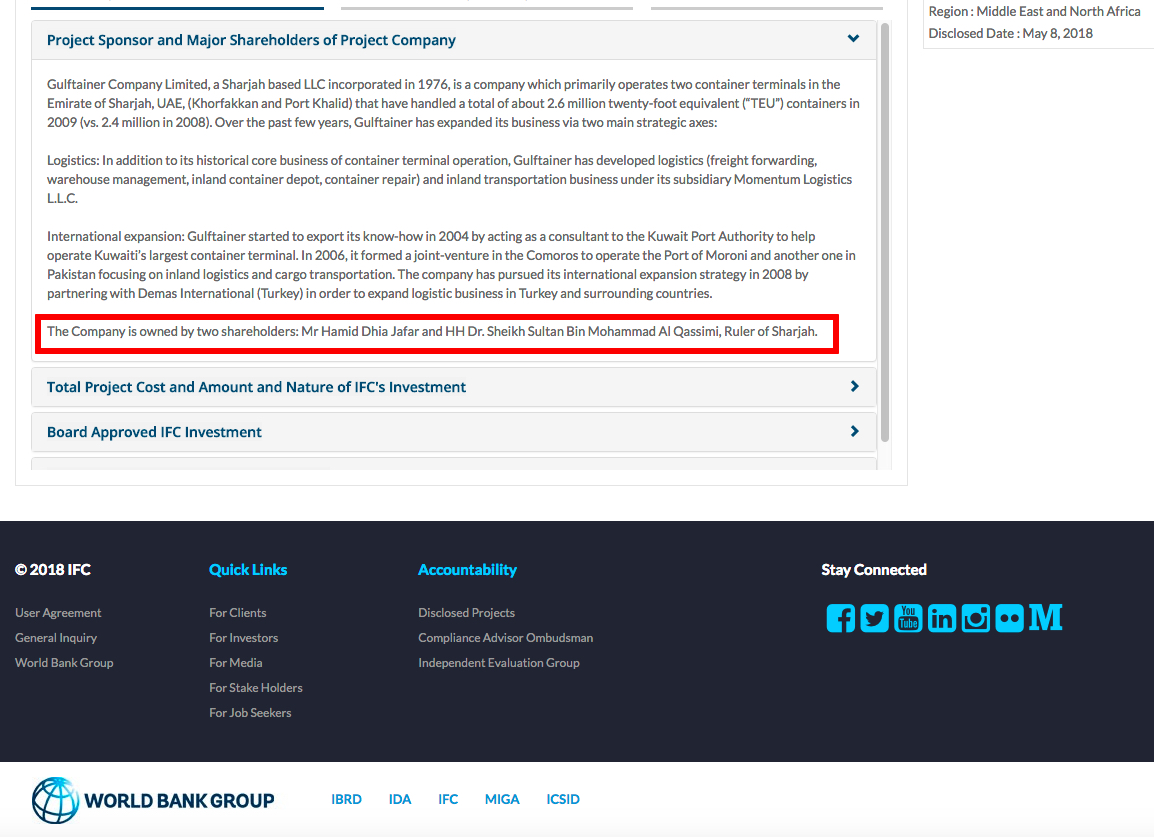
Notably, Ash Carter had previously refused to investigate KGL’s ties to Iran, much to the dismay of several U.S. Senators and Representatives.
Within a few months of Ash Carter’s cancellation of NLOS-LS, Gulftainer entered into a joint venture with Russian state-owned weapons conglomerate ROSTEC.
ROSTEC builds Club-K components and exports the Club-K Container Missile System.
Further increasing the threat, Gulftainer co-owner Hamid Dhia Jafar is the brother Dr. Jafar Dhia Jafar, who masterminded and directed Saddam Hussein’s nuclear weapons program.
Dr. Jafar Dhia Jafar’s masterpiece is the Iraqi miniaturized nuclear implosion device “Beach Ball.” Dr. Jafar designed the spherical “Beach Ball” to fulfill Saddam’s quest for the first “Arab bomb.”
The U.S. government designated Dr. Jafar Dhia Jafar an enemy of the United States and placed him on U.S Central Command’s Operation Iraqi Freedom “Blacklist” as a legitimate military target wanted for capture or kill.
The so-called “Saddam Tapes,” audio recordings discovered by coalition forces in Iraq, reveal Saddam Hussein and his senior cabinet members discussing a scenario in which a nuclear weapon is placed in Washington D.C. yet the blame would go to others. Dr. Jafar Dhia Jafar was a member of Saddam’s cabinet. Dr. Jafar was Saddam Hussein’s Deputy Defense Minister and Senior Presidential nuclear advisor.
Appleby is the Bermuda-based offshore banking law firm made famous by the Paradise Papers. Appleby terminated its client relationship with long-term client Hamid Jafar upon discovering the connections between Hamid Jafar and his brother Dr. Jafar Dhia Jafar to Saddam Hussein’s nuclear weapons program.
The Paradise Papers scandal made headlines around the world as newspapers reported on Appleby and the Jafars.
The Obama administration, however, welcomed the nuclear terrorists connected to Gulftainer and to Russia’s Club-K into America’s ports with open arms — and no national security review.
Badr Jafar, Hamid’s son and Chair of Gulftainer’s Executive Board, visited the Obama White House six weeks before the secret Port Canaveral Gulftainer 35 year lease (code-named “Project Pelican”) was announced and signed in the course of a single day, on June 23, 2014.
Under Secretary Carter canceled NLOS-LS against the advice of nine members of the House Armed Services Committee and two retired U.S. Army four-star generals who helped develop NLOS-LS
The Defense Research Projects Agency (DARPA), the U.S. Army, and Netfires LLC, a Raytheon/Lockheed Martin joint-venture, pioneered and developed NLOS-LS as a core program of the U.S. Army’s $180 billion Future Combat Systems (FCS).
The Future Combat Systems initiative was “the most ambitious and far-reaching modernization the Army has had since World War II” the Defense Department proclaimed in 2006.
The NLOS-LS was one of the flagship weapons systems in Future Combat Systems.
Then first term junior Illinois Senator Barack Obama curiously promised during his 2008 presidential campaign that “I will slow our development of Future Combat Systems.”
Once elected, President Obama did not just “slow” Future Combat Systems. Shortly after his 2009 inauguration, he killed almost entirely the modernization program. The Pentagon had already invested $18 billion in FCS. President Obama’s cancellation triggered an additional half billion dollar loss in cancellation fees alone.
The NLOS-LS survived one year as a Future Combat Systems “spinout,” having demonstrated its capabilities over years of testing, including successful tests in 2006, 2008, and 2009. However, during one test in late 2009 NLOS-LS missed several targets due to a software update. Notwithstanding that the problem was “identified and fixed,” the “failed” test was cited as part of the rationale for the cancellation.
Ash Carter later said in a September 14, 2010 Department of Defense memo that “NLOS-LS’s cancellation would not, in fact, result in a major sacrifice of military capability” despite express disagreement by nine members of the House Armed Services Committee and two retired four-star U.S. Army generals involved in development of the NLOS-LS.
“We would love for this program to go forward – there’s not a lot of investment required to bring it across the line,” retired four-star U.S. Army General Kevin Byrnes, vice president of business development for Army programs at Raytheon Missile Systems, told the Arizona Star. “We believe this is a very, very relevant and capable system for the fights we have on our hands today and the fights we may get into in the future.”
Another retired four-star U.S. Army general, Paul Gorman, who with DARPA developed Netfires NLOS-LS, criticized the pending cancellation in a letter titled “NLOS-LS: Another critical operational capability on the verge of cancellation.”
General Gorman cited the “growing human costs, not only in lives lost, but also in the ever-expanding numbers of wounded warriors.”
General Gorman wrote:
Over the past months our enemies in Afghanistan have found it possible to inflict heavy casualties by attacking the small outposts the coalition has established…A 90 missile NLOS-LS package for 6 FOBs [Forward Operating Bases] could be deployed to Afghanistan with five trucks, 11 personnel, and four C-130 sorties…the prime contractors (Raytheon and Lockheed Martin, partnered in Netfires LLC), have identified the cause, an untried software enhancement just before the firings, and have remedied the defect(s).
U.S. Navy version of NLOS-LS and Russia’s Club-K both launch missiles from standard-sized intermodal cargo containers. Russia markets the Trojan Horse Club-K to carry out treacherous missile attacks launched from civilian ships, trucks, and trains while the NLOS-LS was strictly for military use

NLOS-LS was a high tech manned or unmanned cargo container weapons system for use on land, vehicles, or ships. The NLOS-LS had the capability to communicate with military command and control networks in order to fire precision missiles, guided by laser and infrared and satellite GPS, at multiple “over the horizon” (Non-Line of Sight) high value moving targets.
The NLOS-LS was designed to integrate into a communications network of satellites, aircraft, drones, Navy ships, and mobile command and control centers. NLOS-LS was part of the Pentagon’s new focus on joint forces asymmetric warfare, a strategy to which Russia has moved with the Club-K.
The arrival of NLOS-LS “Missiles in a Box” system was highly anticipated by the U.S. Army and U.S. Navy communities that understood the urgent need to replace 40-year old weapons technology with state of the art futuristic weapons systems that could save lives and win battles. The NLOS-LS was to be a crucial component for the U.S. military’s future success — from the mountains of Afghanistan, to the seas of the Persian Gulf near Iran, to the littorals (shallow waters) found around the world and along America’s coastal zones.
The U.S. Army needed NLOS-LS to defend troops and forward operating bases when air support is unavailable due to weather or aircraft availability.
The U.S. Navy needed NLOS-LS to fend off Iranian-style fast boat swarm attacks and to protect US Marines and Navy SEALs operating ashore.
The U.S. Navy planned to integrate the NLOS-LS into the Surface Warfare “Mission Modules” aboard its futuristic shallow water warships, the Littoral Combat Ships (LCS). The NLOS-LS was packaged into standard-sized intermodal containers called “mission modules” that fit like LEGOs into the Littoral Combat Ship seaframe.
Although the Littoral Combat Ship has been subjected to criticisms over cost, poor stealth capability, its flammable aluminum build, and low combat survivability, the NLOS-LS could have provided the LCS, or any other craft that the Navy might design and commission to operate in the littoral environment, with an effective combat capability. Without the NLOS-LS, the Littoral Combat Ship became less lethal. The NLOS-LS did not need the LCS as much as the LCS needed the NLOS-LS.
RealClear Defense noted in 2014:
Most concerning is LCS’ lack of a credible anti-ship missile. The Navy originally planned a non-line of sight (NLOS) missile launcher for the LCS with a 25-mile range, but the [NLOS-LS] program was cancelled. Now the LCS is armed with the Griffin missile, with just a 5-mile range. This is completely inadequate for a face off with a major surface combatant, especially Chinese vessels whose anti-ship missiles have a range of 100-150 miles.
Eight more years elapsed before the U.S. Navy in 2018 settled on an over-the-horizon missile for the LCS, the Naval Strike Missile built by Raytheon and Norway’s Kongsberg. Boeing and Lockheed dropped out of the competition.
The Pentagon designed the NLOS-LS exclusively for military use and planned to field the NLOS-LS aboard the U.S. Navy’s Littoral Combat Ships and among all 43 U.S. Army Infantry Brigade Combat Teams.
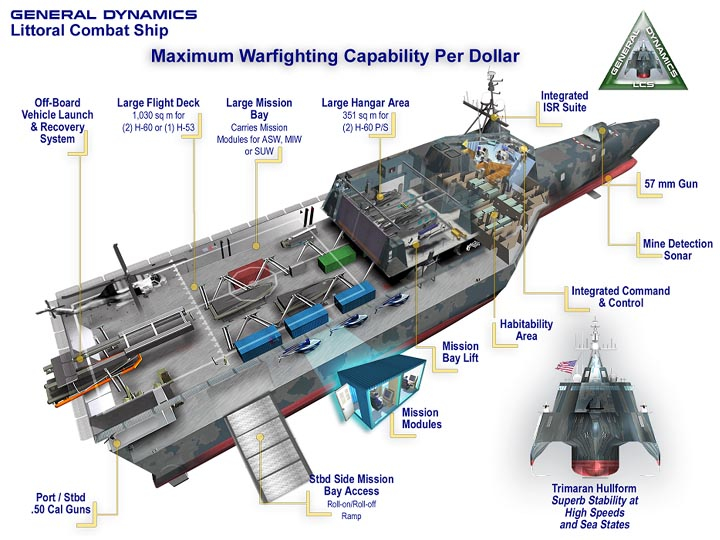
Russia, by contrast, is marketing the Club-K not just for military use, but also for terrorism and perfidy “to kill or injure under cover of civilian status,” according to Robert Clarke from American University Washington College of Law’s Human Rights Brief.
Russia openly markets the Club-K as a Trojan Horse weapons system designed to launch surprise attacks through treachery and deceit by concealment within civilian transportation systems — merchant ships, commercial trucking, and railroads in defiance of the Hague Convention and Geneva Protocol.
Russia’s Trojan Horse version of the “Missiles in a Box” system is designed to look like an innocuous ISO (International Organization for Standardization) intermodal cargo container, yet is a sneaky weapons system meant to deceive. The Club-K looks identical to the ten million cargo containers that enter U.S. ports every year.
According to Dr. Joseph King, former Chief of the National Security Section at the Department of Homeland Security’s New York City Office, less than one-tenth of one percent of cargo containers entering the U.S. are physically inspected. This makes the Club-K incalculably more lethal.
America’s adversaries could smuggle Russian Club-K “cargo containers” into the U.S. homeland through ports adversaries control, load them aboard semi-trucks, boats, and trains, and remotely conduct preemptive strikes from behind U.S. missile defenses.
More concerning, the Club-K launches Russian Kalibr cruise missiles capable of delivering nuclear, electromagnetic pulse (EMP), chemical, biological, and conventional payloads.
EMP expert Dr. Peter Pry told the Washington Examiner that Russia has sold the Club-K to Iran.
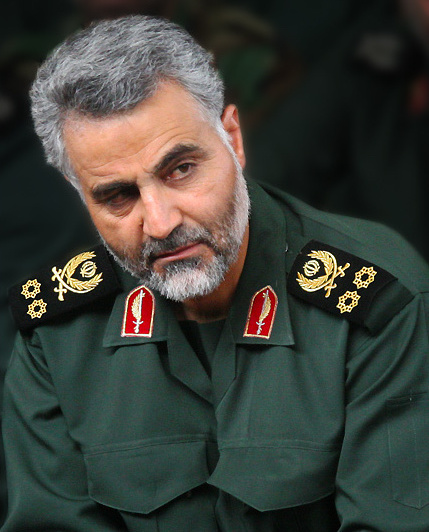
On July 26, 2018, Iranian Major General Qassem Soleimani, the “Shadow Commander” in charge of the Islamic Revolutionary Guard Corps’ Quds Force that conducts clandestine operations for Iran, threatened President Trump and the United States. Soleimani warned America that Iran would “destroy all that you possess” and quoted ancient Chinese military strategist Sun Tzu. “You know our power in the region and our capabilities in asymmetric war…I’m telling you, Mr. Trump the gambler, I am telling you: know that where you are not thinking of, we are near you. Places you cannot imagine, we are next to you.”
Russia’s ROSTEC builds Club-K components, exports the Club-K, and entered into a joint venture with Gulftainer, the recipient of a 35-year container terminal lease at Port Canaveral under the Obama administration. Gulftainer is taking over Delaware’s entire Port of Wilmington for 50 years.
Within months of Ash Carter’s NLOS-LS cancellation and the sudden appearance of Russia’s Club-K marketing campaign, Gulftainer and ROSTEC (the Russian state-owned weapons conglomerate) entered into a joint venture called Gulftainer Russian Technologies.
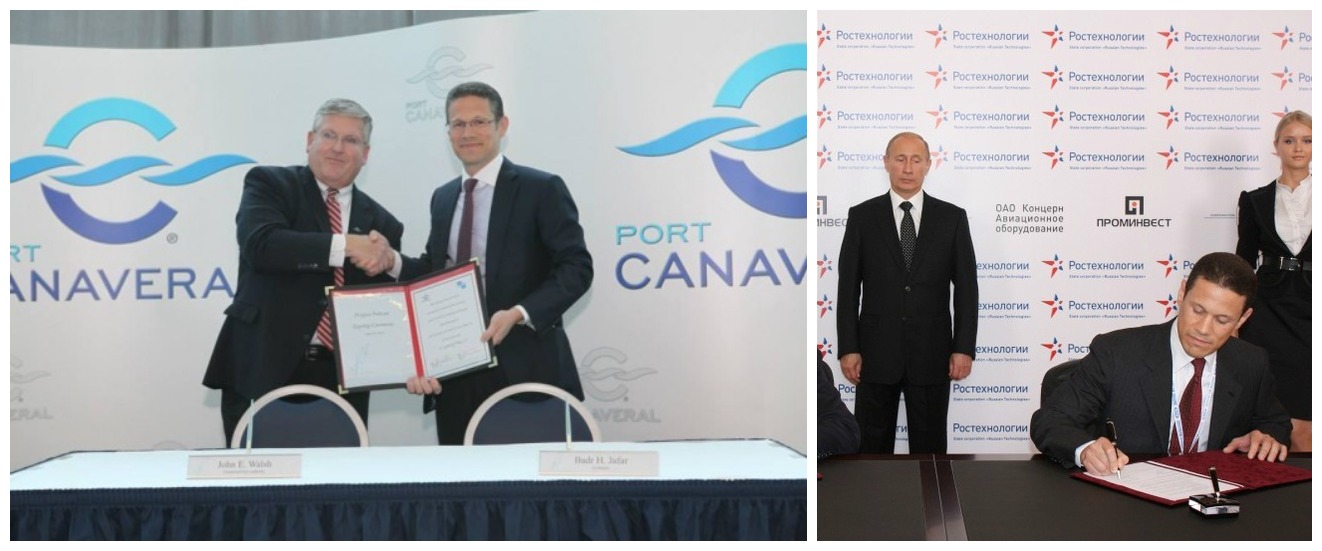
ROSTEC not only manufactures Club-K components but also exports finished Trojan Horse Club-K Container Missile Systems.
ROSTEC subsidiary St. Petersburg-based NII VEKTOR (also known as Scientific-Research Institute Vector OJSC) builds electronic components and systems for the Club-K Container Missile System, according to Aviation Week & Space Technology.
ROSTEC exports the Club-K Container Missile System through its wholly-owned subsidiary, ROSOBORONEXPORT.
That ROSTEC is in a joint venture with the entity that has been granted long-term access to U.S. ports presents a clear and present danger. That ROSTEC’s joint venture partner Gulftainer is connected to Iraq’s WMD programs is beyond concerning.
President Trump placed sanctions on ROSOBORONEXPORT on April 6, 2018, the very day the State of Delaware’s Diamond State Port Corporation Board of Directors voted unanimously to award Gulftainer with a 50-year lease to the entire Port of Wilmington. The Port of Wilmington is located equidistant from New York City and Washington D.C.
National Public Radio (NPR) affiliate Delaware Public Media reported on June 28, 2018 “Gov. John Carney (D) announced Thursday that the Committee on Foreign Investment in the United States (CFIUS) determined the [Gulftainer / Port of Wilmington] deal is ‘not a covered transaction’ and no further review is required at the federal level.”
KGL, GULFTAINER, ASH CARTER, ANOTHER BILLION DOLLARS, AND CARTER’S DISREGARD FOR THE CONCERNS OF U.S. SENATORS AND REPRESENTATIVES
Against the advice of Congressional and military experts and just as Russia began marketing its Trojan Horse weapons system, Ash Carter not only denied the U.S. military and U.S. troops of the use of NLOS-LS, but also awarded Gulftainer consortium partner Kuwait and Gulf Link Transport (KGL) with lucrative U.S. military logistics contracts. KGL is a Kuwaiti ports, transportation, and logistics company.
In June 2013, exactly one year before the “Project Pelican” Port Canaveral/Gulftainer deal was signed, Gulftainer acquired a 51 percent stake in Saudi Arabia’s Gulf Stevedoring Contracting Company (GSCCO), according to Gulf News.
Gulftainer is majority owner in the GSCCO consortium with consortium partner Kuwait and Gulf Link Transport (KGL), co-founder of GSCCO.
Gulftainer’s and KGL’s GSCCO operates cargo container terminals at ports in Saudi Arabia.
While Ash Carter was at the Pentagon, Gulftainer affiliate KGL was awarded over $1 billion dollars in logistics contracts to transport food and other supplies to U.S. troops in the Middle East.
- February 2011, Defense Logistics Agency awards KGL a $157 million contract (ABC News)
- May 2011, US Army awards KGL an $857 million contract (Reuters via GulfBase)
KGL’s U.S. Army contract was expanded in 2016 according to the Army Times.
According to a 2017 “War is Boring” report, a “2017 criminal indictment by Kuwaiti prosecutors points specifically to a KGL affiliate, called KGL Investments [KGLI], as the alleged nexus of fraud and money laundering inside company headquarters from 2007 to 2015.”
Kuwait’s criminal court sentenced KGL Board Chairman Saeed Dashti to 15 years in prison and his deputy Marsha Lazareva, a Russian national who ran KGL Investments (KGLI), to 10 years in prison for, in each case, embezzling a reported $30 million in public money from the Kuwait Ports Authority’s investment in the “Port Fund,” a private equity fund sponsored by and under management of KGLI.
According to a July 16, 2018 press release from Lazareva’s attorneys:
In her capacity at KGLI, Ms. Lazareva managed the creation of an investment property called The Port Fund, whose investors included the Kuwait Ports Authority (KPA) and the Kuwait Public Institution for Social Security (PIFSS). Over its 10-year investment period, in 2017, KGLI was in the process of distributing significant returns from the growth of its Port Fund investments to the limited partners, including the KPA and PIFSS, when $496 million in funds were frozen in a Dubai bank.
Ahmed Mabrouk, a U.S. citizen who was formerly KGLI’s Vice-President Investments, testified about Lazareva and KGLI in a Pennsylvania court case, War is Boring reported.
Mabrouk stated under oath:
Ms. Lazareva described to me the Islamic Republic of Iran Shipping Lines (IRISL) as KGL’s vehicle to Iran and she further told me that IRISL made a lot of money for KGL. When I was employed at KGLI, I observed Ms. Lazareva in her office reviewing documents related to IRISL, which bore the logo of IRISL, as well as the Iranian emblem…
…I understood that Ms. Lazareva and Saeed Dashti took a number of trips on private planes to, among other places, Iran, Syria and Russia. Following each trip, I observed in KGLI’s internal financial statements an influx of funds into KGLI’s accounts. Ms. Lazareva told me and others at KGLI that these trips were for ‘fundraising;’ however, to my knowledge, such fundraising was not tied to any formalized investment process.
War is Boring additionally reported that another KGLI executive testified under oath that KGL funded KGLI:
Another KGLI executive also offered testimony in the same Pennsylvania court case. Wael Salam, an American citizen who worked for KGLI both in Kuwait and in Atlanta, said he was the firm’s Chief Investment Officer. He said both Dashti and Lazareva were directly and deeply involved in decision-making at the firm. He also reported that KGL funded KGLI with money from its subsidiaries as well as seeking contributions from outside investors.
In 2015 the Director of Kuwait Ports Authority (KPA) blacklisted KGL. KPA “terminated the contracts of KGL Holdings and KGL International for Ports Warehousing and Transport” and “called on both companies to evacuate all property and staff from Al-Shuaiba port” Kuwait News Agency reported.
Although KGL had been in the news for its alleged ties to Iran, Ash Carter claimed that KGL did not violate U.S. laws, citing select U.S. government databases. Carter’s carefully crafted letter effectively protected KGL and allowed the contracts to keep rolling in even as multiple investigations and bipartisan inquiries from U.S. Senators Kirk, McCaskill, Menendez, and Rubio and several Representatives were raising alarms about KGL’s extensive ties to Iran.
In 2010, Representatives Tim Ryan (D-OH) and Steve Driehaus (D-OH) wrote a letter to Ash Carter’s boss, Secretary of Defense Robert Gates, urging a “halt to this award” to KGL and noting KGL had “…a dismal human rights record, including its blacklisting from recruiting in India for human trafficking issues.”
The two Congressmen also wrote a letter to Attorney General Eric Holder requesting a DOJ investigation of KGL.
The Project on Government Oversight (POGO) wrote in 2012:
In light of the apparent probe (unmentioned in any of Carter’s letters to lawmakers), his assurances that everything is fine appear, at the least, incomplete and possibly misleading. According to documents and interviews, the FBI, the Defense Criminal Investigative Service, and other U.S. agencies have been actively examining links between Iran and KGL—a process that apparently began well before Carter sent many of his reassuring letters and that seems to be continuing.
The Project on Government Oversight (POGO) followed up in 2018 with another report on KGL:
But KGL has continued to face questions, as in May 2016, when Fuad Dashti — a significant KGL shareholder and brother of its chairman was arrested at San Francisco International Airport and charged with trying to transfer airplane parts to Iran. When he was brought to Washington for FBI interrogation, the U.S. government quietly allowed him to slip out of the country in the waning days of the Obama administration.
POGO also reported on KGL’s joint venture with Iran involving container ships, an illegal sanctions-busting operation concealed through a “ghost structure”:
The KGL lawyer agreed…that KGL had set up a “ghost structure.” When asked about the purpose of the “ghost structure,” the KGL lawyer affirmed that it was to create an intermediary that would relay communications to KGL’s IRISL-affiliated joint venture partner, which fell under U.S. sanctions at the time…i.e., a company that existed in name only, as a go-between for a joint venture it had with a U.S.-sanctioned Iranian partner.
According to PJ Media:
One of KGL’s subsidiaries, Combined Shipping Company, had a joint venture with Valfajr Shipping of Iran — 51 percent KGL, 49 percent Valfajr.
Valfajr is an Iranian government-owned subsidiary of the Islamic Republic of Iran Shipping Lines, or IRISL, Iran’s largest shipping line. In 2008, the Treasury had classified both as Specially Designated Nationals [SDN] (sanctioned company), which blocks their assets and prohibits U.S. citizens from dealing with them.
Kuwait Public Institution for Social Security (PIFSS) claims not only to have been exposed to losses through KGLI’s Port Fund that was managed by Russian national Lazareva, but also claims to have been exposed to the loss of public investment monies at embattled Dubai private equity firm The Abraaj Group.
Gulftainer co-owner Hamid Jafar is a founding shareholder of The Abraaj Group. Gulftainer is a subsidiary of Crescent Enterprises. Crescent Enterprises is a founding shareholder and limited partner of The Abraaj Group according to Crescent Enterprise’s 2016-2017 Annual Report. Gulftainer Executive Board Chairman Badr Jafar is a member of the board of The Abraaj Group.
In June 2018 Pakistan’s Express Tribune, a Karachi newspaper that is “partnered with The International New York Times,” compared collapsing investment firm The Abraaj Group to the notorious Bank of Credit and Commerce International (B.C.C.I.).
TIME Magazine called shuttered B.C.C.I. “The World’s Sleaziest Bank.” The Abraaj Group is facing liquidation in the Cayman Islands, where B.C.C.I.’s subsidiaries B.C.C.I. (Overseas) and International Credit and Investment Company (“ICIC”) were incorporated.
Wahid Hamid, managing partner at the Abraaj Group and a member of Pakistani founder Arif Naqvi’s “inner circle,” was a foreign student at Occidental College who traveled with Barack Obama on a mysterious 1981 trip through Pakistan, attended Obama’s wedding, and flew with President Obama aboard Marine One.
The long-term damage inflicted by Ash Carter’s protection of KGL’s status as an approved Department of Defense contractor continues to reverberate. In 2018, the U.S. military awarded KGL $2 billion in contracts, the Arab Times reported.
Hamid Jafar is also Chairman of Gulftainer affiliate Crescent Petroleum. Breaking U.S. sanctions, Crescent Petroleum maintained an Iran office at the Navak Building on Africa Expressway in Tehran, managed by Hamid Zaheri, a former Iranian government official at Iran’s Oil Ministry. Crescent attempted to hide that information, scrubbing it from a Crescent website.
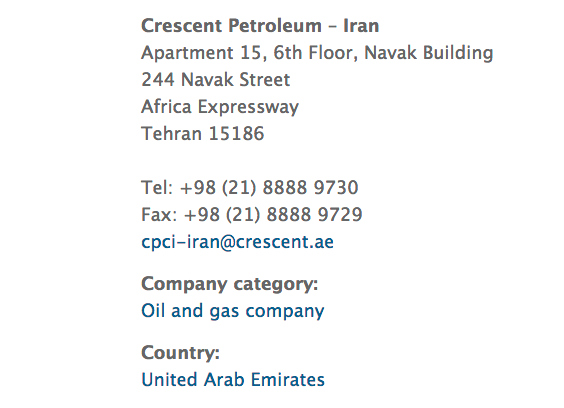
Further, Crescent Petroleum’s former head of strategic planning, Siamak Namazi, was a former Iranian army officer and Iranian regime official who is considered one of the masterminds of the Iran nuclear deal. According to White House visitor logs, Namazi’s NIAC (National Iranian American Council) co-founder Trita Parsi visited the Obama White House 33 times in the run up to the Iran deal. Court documents, from a slander lawsuit, proved Siamek Namazi was passing talking points to Trita Parsi as Parsi visited the White House. It was as if the Iranian regime had moved into the White House.
According to late American lawyer Northcutt Ely, Gulftainer co-owner Hamid Dhia Jafar and his brother Dr. Jafar Dhia Jafar are descended from Iranian royalty — the Qajar dynasty, providing historical context to Gulftainer’s consortium partnership with KGL, a company that ran covert Iranian container shipping operations. The Shiite Qajar dynasty ruled Persia (now Iran) from 1785 to 1925.
ASH CARTER’S RADICAL HISTORY
Ash Carter was a known entity before he joined, and eventually led, President Obama’s Defense Department.
Ash Carter and the Intelligence Community
In 1975, Ash Carter penned two articles for Yale’s campus newspaper. Carter’s words revealed his radical leftist anti-American leanings. Carter slammed the CIA, the Defense Intelligence Agency (DIA), and the wider U.S. intelligence community.
Young Carter wrote that the CIA was staffed by “men whose ideals are outdated.”
Carter wrote in the Yale campus newspaper:
…To add insult to injury and to further complicate the picture, the Defense Intelligence Agency was created in 1961. The Joint Chiefs, unwilling to rely on the CIA, a civilian agency, established the DIA to interpret foreign intelligence in such a way as to promote, in the eyes of policy makers and Congress, militarism, fat Defense budgets, and the Chiefs’ pet projects.
Yet today, Ash Carter stands shoulder to shoulder with former CIA Director John Brennan and former Director of National Intelligence James Clapper against President Trump. Brennan called President Trump’s Helsinki press conference performance with Vladimir Putin “nothing short of treasonous.”
Criticizing President Trump’s meeting with Putin, Carter stated, according to CNN’s Jake Tapper “In my almost four decades with national defense starting in the Pentagon under Ronald Reagan, I never saw or imagined so uneven a handover of American security interests and principles with nothing in return at a meeting. It was like watching the destruction of a cathedral.”
While Ash Carter considered President Trump’s meeting with Vladimir Putin heresy, he had no problem violating federal law.
Defense Secretary Carter, like Secretary of State Hillary Clinton, used a personal email account and personal electronic devices to conduct official business, according to the New York Times. Carter continued conducting his illegal email practices for months after the Hillary Clinton email scandal became public.
Ash Carter and America’s Nuclear Triad
Carter was accused of attempting to decimate America’s last defense — the hallowed nuclear triad.
In 1994, during President Clinton’s first term, Carter tried to dismantle America’s sacred nuclear triad while he co-chaired the first Nuclear Posture Review (NPR), stunning flag officer strategic commanders. By exploiting the NPR process, Carter attempted to cut two legs out from under the nuclear triad stool — the long-range alert bombers and the missile silos — and to shorten the third leg of the stool by reducing the number of submarines on patrol with nuclear ballistic missiles to around 10 “boomers.”
Foreign Policy reported in 2015:
The budgetary situation in the United States is driving Washington toward the elimination of the ICBM force and the conventionalization of U.S. bombers, leaving deterrence to rest on U.S. ballistic missile submarines at sea. This is precisely the posture that Carter was accused, in leaks and congressional letters, of seeking in 1994.
Ash Carter and Reagan’s “Star Wars” Strategic Defense Initiative (SDI)
In 1984, Ashton Carter authored a background paper highly critical of President Reagan’s “Star Wars” Strategic Defense Initiative (SDI). Carter later boasted that his paper was “the first authoritative report to say that the emperor has no clothes.” Two years after Carter’s paper the Heritage Foundation published a report titled “While Opposing Reagan’s SDI Moscow Pushes Its Own Star Wars.”
President Clinton’s Defense Secretary Les Aspin, Carter’s old boss, was not about to be left out of the spotlight. Aspin also gloated about killing SDI and boasted that “I took the stars out of Star Wars,” according to Dr. Peter Pry.
In 1994 Secretary Aspin resigned in disgrace. Aspin denied requests from U.S. troops in Somalia for tanks and armored vehicles several days before the “Black Hawk Down” Battle of Mogadishu. Aspin also denied fixed-wing air support during that bloody battle that left 18 U.S. troops dead and 73 wounded. The echoes of Aspin’s dereliction of duty in Somalia can be heard during the 13-hour firefight in Benghazi, where help never arrived, and in Carter’s cancellation of NLOS-LS, a weapon system that could have saved the lives of untold numbers of U.S. troops.
The NLOS-LS was designed to protect remote outposts such as the mission in Benghazi, Libya. Had the CIA Annex in Benghazi been protected by an NLOS-LS, jihadi militants would have been stopped dead in their tracks.
The record shows that Ash Carter’s actions weakened the U.S. military to the benefit of Russia and, in many instances, also to the benefit of Iran.
The Club-K Container Missile System can be used as a “first or second strike weapon” Lajos F. Szaszdi wrote at the Daily Signal in 2011:
The Club-K is a highly destabilizing weapon system…it would be very hard to detect, and an attack could happen at any time on any day without warning. The military and intelligence services of the U.S. and its allies must keep a close watch on this Pandora’s Box, to make sure it will never be opened in anger against them.
In 2018, both Russia and Iran have been saber rattling. Putin’s video of Russian missiles raining down on Florida and Iranian Quds Force commander Soleiami’s threats of “asymmetric warfare” and his Sun Tzu quote directed at President Trump, “where you are not thinking of, we are near you. Places you cannot imagine, we are next to you” should not be dismissed as harmless bluster.
During an October 4, 2016 speech (VIDEO), United States Army Chief of Staff General Mark A. Milley warned that “history teaches us to be careful. It’s always wise to believe foreign leaders’ declaratory policy, especially when it’s as threatening as these are, as most nations tend to telegraph their strategic intentions.”
Iran appeared to telegraph its strategic intentions in 2017 when it released a chilling propaganda video featuring a soccer ball on the beach, a nuclear reactor, and the destruction of a U.S. Navy fleet. The design of soccer-ball-shaped nuclear weapon developed under Iran’s AMAD Project closely resembles Dr. Jafar Dhia Jafar’s Iraqi “Beach Ball.”
It is long past time to embrace President Ronald Reagan’s “Peace through Strength” doctrine that President Trump has adopted.
Reagan advocated for “Peace through Strength” as the bedrock of his foreign policy and explained it in 1986:
We know that peace is the condition under which mankind was meant to flourish. Yet peace does not exist of its own will. It depends on us, on our courage to build it and guard it and pass it on to future generations. George Washington’s words may seem hard and cold today, but history has proven him right again and again. “To be prepared for war,” he said, “is one of the most effective means of preserving peace.”
“The first strike, known as the decapitation strike, is designed to remove the enemy’s control and command mechanisms with the intent that it will destroy or negatively affect its capacity to lead to nuclear retaliation” according to “War History Online.”
Even just one Club-K Container Missile System could launch an EMP attack that could disable America’s power grid and impede America’s ability to respond with a retaliatory strike. In theory, Russia and other adversaries could carry out a coordinated first strike surge attack from hundreds or even thousands of Club-K Container Missile Systems secreted behind U.S. missile defenses. Additional missile salvos could be launched from Club-K units in Mexico and from merchant ships and submarines off the U.S. coasts. Likely targets would be U.S. Navy submarine bases in Kitsap and Kings Bay, U.S. Air Force strategic bomber air bases, command and control bases and the Boeing E4B airborne command 747s.
The advent of the Club-K has neutered and made obsolete the doctrine of Mutually Assured Destruction (MAD). MAD can no be relied on as a means of ensuring peace.
Dr. Peter Pry on Strategic Defense Initiative (SDI)/Brilliant Pebbles and Mutually Assured Destruction (MAD): “…defending American lives, instead of merely avenging millions of dead”
Dr. Peter Pry, in an exclusive interview with Mary Fanning in July 2018, stated:
President Clinton’s Secretary of Defense Les Aspin, when he boasted he “Took the stars out of Star Wars,” was terminating Ronald Reagan’s Strategic Defense Initiative that envisioned space-based missile defenses that would render nuclear missiles obsolete.
Tragically, as Ambassador Henry Cooper (former SDI Director) has written, the Clinton Administration killed the opportunity to deploy Brilliant Pebbles — space-based defenses that were then ready for deployment — leaving America naked to the nuclear missile threats we face today from Russia, China, North Korea, and Iran (this last soon, if not now).
Why did Clinton and Les Aspin (and Ash Carter) kill SDI and Brilliant Pebbles? Democrats and the Left long regarded the ABM Treaty as the “cornerstone of strategic stability” because they believed in the policy of Mutual Assured Destruction (MAD). Space-based defenses that could defend the American people from large-scale nuclear missile threats would cancel the mutual vulnerability at the basis of MAD. Deployment of space-based defenses, or of any missile defenses capable of defending America from large-scale nuclear missile attacks, would require U.S. withdrawal from the ABM Treaty limiting such defenses. In short, the Clinton Administration killed SDI and Brilliant Pebbles because they saw these as threats to the ABM Treaty and MAD, the fake “cornerstone of strategic stability.”
When President George W. Bush eventually withdrew from the ABM Treaty to deploy the U.S. National Missile Defenses, he made the mistake of letting Democrats and the Deep State “dumb down” those defenses so they cannot shield America from attacks from Russia or China, and perhaps not even from North Korea.
But President Trump can bring back SDI and Brilliant Pebbles and correct the mistakes of the past. Amb. Cooper estimates Brilliant Pebbles can be deployed, on a crash basis, before the end of a Trump second term, for a cost of $20 billion. Thus, President Reagan’s vision of defending American lives, instead of merely avenging millions of dead, could be realized.
THE ENEMY IS INSIDE THE WIRE AND DISASTER IS ON THE HORIZON
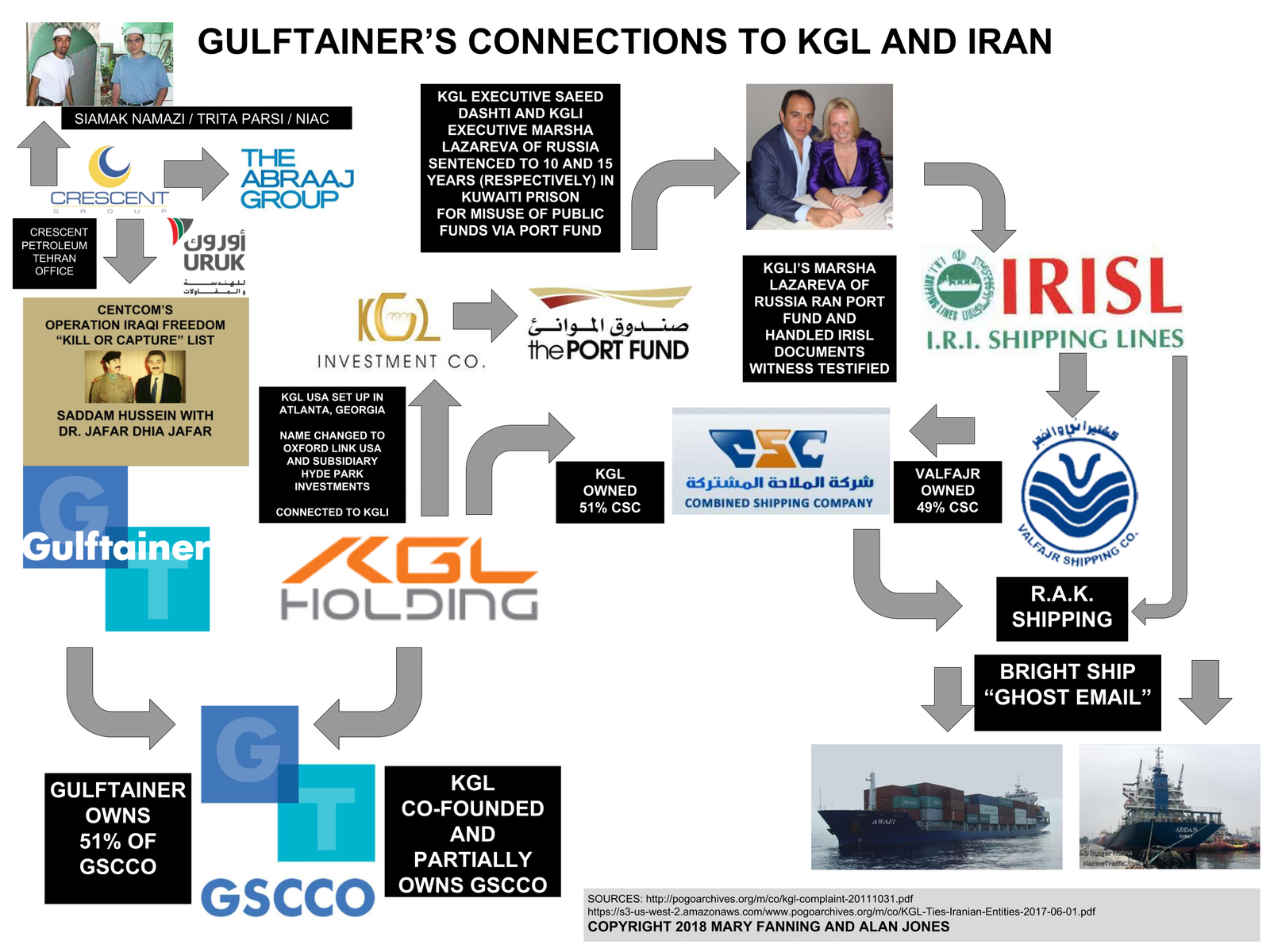
Ash Carter and the Obama administration left behind several time bombs that threaten the United States today and into the future.
Against the advice of retired U.S. military generals and sitting U.S. Senators and Representatives, including multiple members of the House Armed Services Committee, Ash Carter awarded KGL with logistics contracts to deliver food — the “beans” portion of “beans and bullets”– to U.S. troops. KGL also transports U.S. military personnel in the Middle East under those same Department of Defense contracts.
“I am deeply concerned by information that suggests the U.S. Army and Defense Logistics Agency may be contracting sensitive military logistics services to an entity tied to Iran’s primary shipping company,” Illinois Senator Mark Kirk told ABC News in 2011.
Peter Richards, Gulftainer Group Managing Director, boasted in a Gulftainer press release announcing the 2013 GSCCO deal that brought Gulftainer and KGL together, “This is an exciting time for Gulftainer as we increase our footprint across the Middle East.”
In 2015, Peter Richards, as CEO of Gulftainer’s GT USA, bragged (video 6:20 mark) during a Port Canaveral event “We actually cooperate with your own military. We actually provide the logistics for the American forces in the Middle East.”
Peter Richards told members of the public during an April 6, 2018 Gulftainer port lease hearing in Wilmington, Delaware “We’re an international company. We’ve actually been working in the USA for the last four years. We actually service the American military. We actually service the US Coast Guard. We’re actually involved in the space industry down there. We’re in a position of trust.”
By forging a business alliance between Gulftainer and KGL through GSCCO, the Iraqi Jafar family and Gulftainer executive Peter Richards pulled off a clever business maneuver that serves several purposes that jeopardize U.S. national security.
The success of that operation depended on Ash Carter keeping KGL in good standing within the Department of Defense while deflecting congressional demands for a KGL investigation.
KGL received its first Department of Defense contracts before it became an affiliate of the Jafars and Gulftainer.
Gulftainer’s ascendancy mirrored Barack Obama’s. (SEE APPENDIX: GULFTAINER’S RAPID EXPANSION DURING BARACK OBAMA’S POLITICAL CAREER)
Prior to Barack Obama’s rapid and brief ascendency into the U.S. Senate, followed by his 2008 presidential election, Gulftainer was barely on the radar and operated primarily as a small local UAE business.
“Containerisation International” wrote in 2008:
Sharjah-based Gulftainer Company Ltd is not a renowned international terminal operating company, but the past 18 months have seen the group invest in several overseas port and freight logistics projects…Gulftainer is one of the more recent entrants into the international container terminals and stevedoring sector.
By the end of President Obama’s two terms at the White House, Gulftainer was boasting that it had become “the largest privately held port operator in the world.”
Gulftainer’s consortium partnership with KGL provided Gulftainer with a much-needed imprimatur, cloaking Gulftainer with an aura of legitimacy, as it made inroads into sensitive U.S. port infrastructure near American military and space operations.
Without mentioning KGL by name, a brand that became highly tainted due to KGL’s multiple ties to Iran, Peter Richards made a habit of bootstrapping Gulftainer to KGL by touting Gulftainer’s supposed military logistics contracts while daring to tell the American people that a company connected to the very Saddam Hussein loyalists who funded and designed Saddam’s WMD programs was “trusted.”
The Iraqi family who funded and built Saddam Hussein’s WMD program is not only inside the U.S. military logistics network but also inside the wire of the U.S. homeland in two major U.S. strategic ports with 35 and 50-year leases.
Gulftainer is owned in part by the Iraqi family who was deeply involved with Saddam Hussein in the acquisition of weapons of mass destruction and is in a partnership with the Russian company that builds parts for and exports delivery systems for such WMD weapons, concealed in the stealth Club-K Trojan Horse cargo container. That same Iraqi family now has access to two critical infrastructure U.S. ports.
That very same family is also in a consortium with KGL, the recipient of Department of Defense logistics contracts to transport U.S. military personnel and food for U.S. troops in the Middle East.
Peter Richard’s statements suggest that Gulftainer and KGL are really one single enterprise. Either they are not affiliated or Richards’ words are an admission of a combined enterprise in which case the sins of one apply to the other. Both entities are tainted with murky connections and histories in which case the totality of the enterprise should be thoroughly reviewed by CFIUS.
Ash Carter ignored the deep security concerns of U. S. Senators and Representatives regarding KGL and its connections to Iran, allowing KGL’s contracts with the U.S. military to remain in effect.
To invite such a malignant enterprise into America’s ports and into the Department of Defense logistics network is like stepping through the looking glass where down is up, where wrong is right, where adversaries are allies, and where treason is fidelity.
One would have to scour the globe to find a company more treacherous than Gulftainer and with contacts and partnerships more egregious than those of the Jafar family. Yet Ash Carter and the Obama administration chose to implement contracts with Gulftainer and KGL and without the required National Security Threat Analysis CFIUS review as mandated by the Foreign Investment National Security Act of 2007 (FINSA).
To think that a declared enemy of the U.S., partnered with the Russian company that exports the Trojan Horse weapons system Club K that can take out all or even just part of the entire nation, has been handed two strategic U.S. critical infrastructure ports is beyond deranged. It is enemy action.
Consider the absurdity of hiring a logistics company in a consortium partnership with a company co-owned by an Iraqi whose brother and business partner, according to CIA documents, oversaw procurement for Saddam’s biological and chemical weapons programs, to deliver food to U.S. troops.
However, that is exactly what the Obama administration and Ash Carter did.
United States Navy Admiral James “Ace” Lyons (Ret.), former Commander in Chief of the U.S. Pacific Fleet, upon hearing these facts in an exclusive interview by Mary Fanning in July 2018, stated “This is treason. This is an act of sedition. Ash Carter and those who worked with him must be held accountable. He clearly violated his oath of office.”
Offshore banking law firm Appleby refused Hamid Jafar further access to Appleby’s services precisely because of Hamid Jafar’s connections to Saddam Hussein’s Iraqi WMD programs with his brother and business partner Dr. Jafar Dhia Jafar. Yet, Ash Carter and the Obama administration brought the same Iraqi Jafar brothers into America’s ports beside U.S. Navy submarines carrying nuclear missiles and NASA’s Kennedy Space Center and into the U.S. military’s sensitive Middle East logistics and food supply chains.
“Anybody with a lick of sense, let alone with serious national security responsibilities in the U.S Government, would see that this kind of deal, with this kind of company, with its kind of partners, is something that rises to the first order of national security concerns” said Frank Gaffney, former Acting Assistant Secretary of Defense for International Security Affairs during the Reagan administration and Founder and President of the Center for Security Policy.
What could possibly go wrong? Absolutely everything.
APPENDIX:
GULFTAINER’S RAPID EXPANSION DURING BARACK OBAMA’S POLITICAL CAREER
🇦🇪1976 GULFTAINER FOUNDED AND MANAGES CONTAINER TERMINAL IN SHARJAH, UAE
🇦🇪1986 GULFTAINER BEGINS MANAGING SECOND UAE TERMINAL
2005 BARACK OBAMA BECOMES A U.S. SENATOR FROM ILLINOIS
🇵🇰 2006 GULFTAINER LAUNCHES CARGO LOGISTICS JOINT VENTURE IN PAKISTAN
🇰🇲 2006 GULFTAINER WINS 15 YEAR CONTRACT TO MANAGE PORTS IN COMOROS ISLANDS, AFRICA
🇮🇳 2007 GULFTAINER SIGNS STRATEGIC AGREEMENT WITH HYDERABAD, INDIA-BASED LANCO INFRATECH LTD
🇹🇷 2008 GULFTAINER LAUNCHES JOINT-VENTURE WITH TURKISH COMPANY TO LAUNCH MOMENTUM LOGISTICS.
2009 PRESIDENT OBAMA BEGINS HIS PRESIDENCY
🇦🇪 2009 GULFTAINER’S MOMENTUM LOGISTICS WINS ABU DHABI, UAE CONTRACT
🇮🇶 2010 GULFTAINER BEGINS OPERATING AT IRAQ’S PORT UMM QASR
🇷🇺 2011 GULFTAINER ENTERS DEAL TO DEVELOP RUSSIAN PORTS
🇧🇷 2011 GULFTAINER SIGNS CONTRACT TO BEGINS OPERATIONS IN BRAZIL
🇮🇶 2012 GULFTAINER EXPANDS OPERATIONS AT IRAQ’S PORT UMM QASR
🇱🇧 2012 GULFTAINER WINS 25 YEAR CONTAINER TERMINAL CONCESSION AT LEBANON’S PORT OF TRIPOLI
🇺🇸 2012 GULFTAINER ATTEMPTS TO TAKE OVER JACKSONVILLE’S PORT OF JACKSONVILLE, NEAR NAVAL SUBMARINE BASE KINGS BAY
🇮🇶 2013 GULFTAINER BUILDS LOGISTICS CITY AT IRAQ’S PORT UMM QASR
🇸🇦 2013 GULFTAINER TAKES MAJORITY STAKE IN GSCCO, ALONGSIDE GSCCO CO-FOUNDER KGL, AND TAKES OVER CONTAINER TERMINALS IN SAUDI ARABIA
🇺🇸 2014 GULFTAINER AWARDED 35-YEAR CONTAINER TERMINAL LEASE AT FLORIDA’S PORT CANAVERAL, NEAR US NAVY SUBMARINES AND NASA’S KENNEDY SPACE CENTER, FOLLOWING SECRET “PROJECT PELICAN” NEGOTIATIONS
🇺🇸 2018 GULFTAINER AWARDED 50-YEAR LEASE LEASE AT DELAWARE’S PORT OF WILMINGTON
*** COPYRIGHT 2018 MARY FANNING AND ALAN JONES






